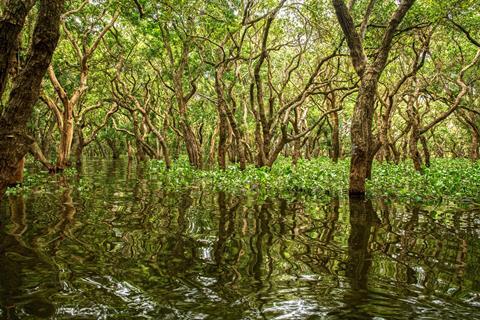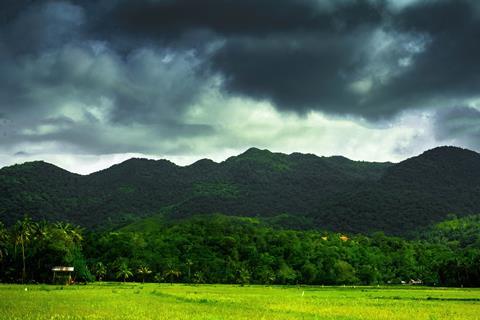As the demand for natural products, bioactive compounds, essential fatty acids, and carotenoids increases with the world’s population, more research studies must delve into alternative sources that would likely help address major global demands.
The need to look for alternative solutions and sources that are sustainable, economically competitive and viable smart sources is indeed a challenge. Fatty acids, specifically the omega-3 and omega-6 fatty acids, from fish oils and plant-based fatty acids are depleting due to the continuous harvesting of raw materials. Studies on other sources of these natural products have increased significant interest recently because of their importance and demands in aquaculture feeds and biofuel production.
The Philippines is one of the world’s most biodiverse mangrove countries. Mangroves are considered one of the most productive biomes that play essential roles by serving as habitats for different organisms, preventing erosion and protecting the coastal ecosystem, and as a site to various biogeochemical cycles. There are over 50 known species of mangroves in the Philippines. The most common species include Rhizophora mucronata, Rhizophora stylosa, Bruguiera spp., Sonneratia alba, Avicennia offinalis, Avicennia marina, and Xylocarpus and together form approximately 20-30% of the world’s total mangrove species. Within the mangrove ecosystem, a group of fatty acid-producing microorganisms (i.e. oomycetes and thraustochytrids) are considered microbial treasures with biotechnological importance.

The industry and food biotechnology of The Philippines continuously expand in their production of nutraceuticals, medicines, food and feed products, and others. Therefore, it will continue to look for alternative sources to provide consumers with higher amounts of reasonably priced omega-3 and omega-6 fatty acids as essential fatty acids and other natural products. We would like to address this opportunity by prospecting for industrially viable strains of oomycetes and thraustochytrids from the mangrove environment capable of producing valuable fatty acids and other compounds. Through this endeavour, the Philippines may envision the large-scale local production of these health-beneficial and industrially important compounds in the near future.
The discovery of oomycetes and early research
Oomycetes and thraustochytrids are a group of fungus-like microorganisms commonly found in aquatic environments. They are known to feed on various organic materials, including moribund plants, micro- and macroalgae, and some animal species. Further, members of the oomycete and thraustochytrid groups are distributed worldwide and are currently being explored for their biotechnological importance. The occurrence of oomycetes and other zoosporic fungi in the Philippines, particularly the Halophytophthoras and thraustochytrids were initially reported by Dr Eduardo Leaño in 2001 in Panay Island. However, research works on these interesting microorganisms after that of Leaño’s work became stagnant, which resulted in a huge literature gap for the Philippines. It was then we realised the need to explore further the diversity of oomycetes and thraustochytrids in the Philippines and expand upon Dr Leaño’s initial work in Panay Island.

Considering the country’s climate and geography, we assumed that diverse species of oomycetes and thraustochytrids were witing to be discovered. In 2011, we started our preliminary work on the cultural optimisation of thraustochytrids for biomass and fatty acid production. From this report, we reported two species of thraustochytrids (Thraustochytrium sp. SB04 and Schizochytrium sp. SB11) and detected interesting fatty acids, such as myristic acid, palmitic acid, stearic acid, oleic acid, linoleic acid, linolenic acid, and docosahexaenoic acid (DHA). The fatty acid production (e.g. polyunsaturated fatty acids, monounsaturated fatty acids) by these microorganisms was given much attention by researchers in other countries such as Taiwan, Japan, Australia, and Brazil but remained limited in the Philippines despite its diverse mangrove ecosystem. Thus, we explored the fatty acid profiles of our indigenous thraustochytrid isolates and looked forward to their potential for industrial applications.
In 2017, Bennett and colleagues brought an end to the decade-long drought of oomycete literature in the Philippines. The distribution and taxonomy of mangrove oomycetes found in different islands in the Philippines, from Luzon to Mindanao, were explored and reported. They have reported on interesting species from the Philippines, which include Phytophthora insolita, Phytophthora elongata, Phytopythium leanoi, Phytopythium dogmae, Salispina hoi, and other ubiquitous mangrove oomycetes (e.g. Halophytophthora spp., Salisapilia spp., Salispina spp.). Further, these taxonomic reports paved the way for stronger collaborations in Japan and Germany, and initiated a stronger study on fatty acid content analysis, and their potential to benefit society and the nutraceutical industry.
We discovered that mangrove oomycetes and thraustochytrids, produced mainly monounsaturated acids, as well as several polyunsaturated fatty acids. We hypothesise that fatty acid synthesis occurs in the cytoplasm of the cell. The process involves a sequential complex of an enzymatic pathway that involves multiple catalytic steps and carbon-carbon reactions. Further, fatty acid biosynthesis is vital for the growth and survival of oomycetes and thraustochytrids and allows them to synthesise lipids for cell growth, development, and reproduction. From this premise and by taking advantage of the physiology of these microorganisms, we further expanded by searching for competitive strains capable of producing omega-3 and omega-6 fatty acids by altering culture conditions (e.g. pH, temperature, salinity, duration of incubation, light intensity, glucose, and nitrogen sources) and setting cellular and molecular triggers that will enhance fatty acid production.

Fatty acids and their health benefits
Omega-6 fatty acids are found in many common vegetable oils and other meat and dairy products. Whereas omega-3 fatty acids are found mainly in fish (e.g. tuna, salmon) and seeds (e.g. hemp, chia, flaxseeds, sunflower, sesame) and present tremendous health benefits, such as enhancing brain development and function, and promoting normal physiological processes in the human body. Other health benefits of these fatty acids have been shown to include enhancing the immune system and preventing the occurrence of cardiovascular diseases through lowered blood viscosity, blood pressure reduction, lowering the count of low-density lipoproteins in the blood, improving levels of triglycerides and preventing cardiac arrhythmias. Interestingly, these fatty acids are produced abundantly by oomycetes and thraustochytrids after successful alteration of culture conditions and can therefore alleviate pressure on ocean and land-based resources by serving as single-cell sources of PUFA and carotenoids.
In our recent research work on mangrove oomycetes, twenty-one species of Halophytophthora spp. and two species of Phytopythium spp. were found to produce palmitic acid (C16:0), linoleic acid (C18:2n6c), and oleic acid (C18:1n9c) cis-11,14,17-eicosatrienoic acid (C20:3n3), and stearic acid (C18:0) ranging from 2-30% total fatty acids. An omega-6 fatty acid, Ƴ-linolenic acid (C18:3n6), was found in Phytopythium isolates with considerably higher concentrations than Halophytophthora spp. The omega-3 polyunsaturated fatty acid, cis-11,14,17-eicosatrienoic acid (C20:3n3), was detected in most oomycete isolates. We also hypothesised that the identified fatty acids might also be used as a chemotaxonomic guide in the identification and phylogeny of mangrove oomycetes and, possibly, be applied for thraustochytrids, as well. The latter concept will potentially translate to identifying targeted groups for efficient isolation of better isolates.
In the work of graduate student Mark Kevin Devanadera, the cytotoxic and anti-cancer activities of fatty acids from Sailspina hoi USTCMS 1611 and two strains of Halophytophthora (T12GP1 and T12YBP2) against breast adenocarcinoma cells (MCF7), was reported in 2019. The crude fatty acids from Halophytophthora spp. (strains T12GP1 and T12YBP2) and Salispina hoi (USTCMS 1611), were explored for their cytotoxic and apoptotic effects against human adenocarcinoma/breast cancer cells (MCF7) and normal human dermal fibroblasts (HDFn). Interestingly, the crude fatty acids showed no toxicity on HDFn cells but had toxic effects against MCF7 cells. The latter cells exhibited a deformed cell membrane, DNA aggregation, and nuclear membrane disruption. The breast cancer cells also undergo reactive oxygen species (ROS) mediated and non-ROS mediated apoptosis due to the effect of fatty acids on lipid peroxidation activity of the cells and in the cellular oxidative stress. However, more investigations using modern technologies must be done to obtain more valuable information about the potential of these microorganisms. At some point, this has opened more opportunities for these microorganisms to be studied further. From our findings, we inferred that fatty acids sourced from mangrove oomycetes were found to induce cell death of the cancer cells and would translate to opening new doors for cancer treatment and medication by as a potential drug, drug additive or part of delivery systems, or dietary supplement.

Recent studies have shown the beneficial effects of fatty acids in the treatment of various diseases such as asthma, rheumatoid arthritis, osteoporosis, and in most cancers such as colon, breast, prostate, and other malignancies. Thus, we hope that more researchers will investigate this potential and feasible use of fatty acids from oomycetes by understanding the mechanism of fatty acid metabolic pathways and the effect of fatty acids in the cancer cell membrane in cancer therapy to improve the quality of life. The mangrove oomycetes and thraustochytrids that our laboratory explores are potential answers to the real-world problem of the increased demand for fatty acids and other natural products. Further, we know that excessive harvesting of traditional sources of fatty acids will result in biodiversity loss – this, another enigma of biodiversity, can be cushioned by exploring the mangrove oomycetes that can be grown and mass-produced easily in a laboratory. Another issue is the inevitable emergence of various diseases. Since we are trying to elucidate the potential of fatty acids against different diseases and pathogenic microorganisms, we are looking at the possibility of developing new formulations and medications that could be used in the pharmaceutical industry and medicine. Our research also calls for the protection of the mangrove environment. The Philippines is currently experiencing a major threat to the current health status of its mangrove environment.
About 50-70% of the original land cover of Philippine mangrove is threatened due to habitat loss, pollution, and overpopulation. We call for a better implementation to conserve and protect the mangrove environment since it not only protects the coastline environment but, more importantly, it harbours highly beneficial microorganisms.
The future of this work includes the continuous search for competitive and high-yield strains, engineering strains for commercial use, and feasible applications for commercial and economic viability. Searching for champion strains must continue, which we can hopefully offer to the public and our industrial partners.








No comments yet